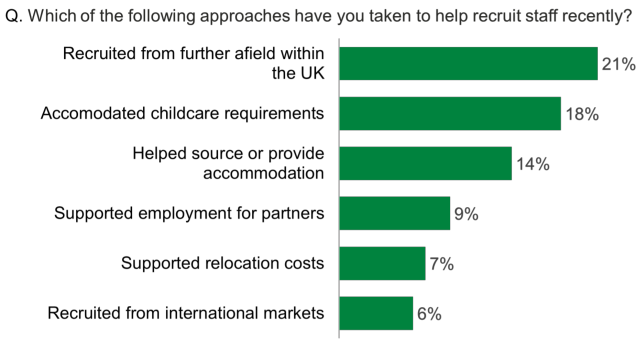Rural Scotland Business Panel Survey February 2023
This report presents findings from the fourth Rural Scotland Business Panel Survey carried out in October and November 2022.
8. Ownership and recruitment
Key findings
Among employers, over four-fifths (84%) described themselves as family-owned, while 11% were employee-owned. More than one-in-ten (13%) businesses were women-led.
A quarter (24%) of businesses had recruited staff at some point in the past six months. Among those that had, 21% had recruited from further afield in the UK, while 6% had recruited from international markets. Just under one in five (18%) had helped with childcare requirements, 14% had either provided or helped source accommodation, 9% had supported employment for partners and 7% supported relocation costs.
Most (72%) businesses that had hired staff in the past six months said that word of mouth or personal recommendations was the most effective method of recruitment. Around half (47%) said that social media adverts were most effective, followed by paid-for recruitment services (25%) or advertising jobs on their own website (23%).
Profile of business ownership
Among employers, over four-fifths (84%) described themselves as family-owned, while 11% were employee-owned (with employees owning a majority of the shares). More than one-in-ten (13%) businesses were women-led. (Figure 8.1).

Variation in business ownership
Business more likely than average to be family-owned were:
- food and drink (95%),
- those with 1-4 staff (84%) and
- those in South of Scotland (88%) and accessible rural locations (87%) (which may reflect the higher proportion of accessible rural businesses in the South of Scotland).
Sectors with higher proportions of both women-led and employee-owned businesses were:
- Creative industries (22% and 25% respectively), and
- Financial and business services (18% and 29%).
Recruitment
A quarter (24%) of businesses had recruited staff at some point in the past six months. This rose to 32% of businesses in the Highlands and Islands (compared with 21% in the South of Scotland and 22% in rest of rural Scotland).
Among those that had recruited staff, 21% had done so by looking further afield in the UK, while 6% had recruited from international markets. Just under one in five (18%) had helped with childcare requirements, 14% had either provided or helped source accommodation, 9% had supported employment for partners and 7% supported relocation costs (Figure 8.2).

Variation in level and approaches to recruitment
Recruitment was more common among larger businesses (e.g. 70% of those with 11-24 and 93% of those with 25+ staff), tourism businesses (42%) and those that had performed well in the past six months (35%).
In terms of specific methods, businesses in the Highlands and Islands were more likely than average to have helped source staff accommodation (27%), supported relocation costs (13%) and recruited from international markets (11%).
Remote rural businesses were more likely to have recruited from further afield in the UK (28%), sourced or provided accommodation (32%) and supported partner employment (16%) and relocation costs (13%).
The following sectors were also more likely to have used certain approaches:
- Tourism – helped source of provide accommodation (30%), support employment for partners (23%) and support relocation costs (13%).
- Food and drink - helped source of provide accommodation (32%) and support relocation costs (13%).
- Financial and business services - recruited from international markets (12%).
Effectiveness of recruitment channels
Most (72%) businesses that had recruited in the past six months said that word of mouth or personal recommendations was the most effective method. Around half (47%) said that social media ads were most effective, followed by paid-for recruitment services (25%) and advertising jobs on their own website (23%) (Figure 8.3).

Variation in perceived efficacy of recruitment channels
Larger businesses (25+ staff) were more likely to say that social media ads (65%),
paid-for recruitment services (43%) and advertising on their own website (42%) were the most effective recruitment channels.
Other variation included:
- Remote rural businesses - word of mouth or personal recommendations (80%).
- Tourism and employee-owned businesses – adverts on their own website (31% and 39%)
- Women-led businesses - social media advertising (65%).
Contact
Email: socialresearch@gov.scot
There is a problem
Thanks for your feedback